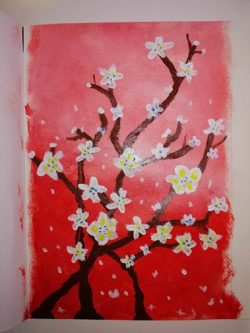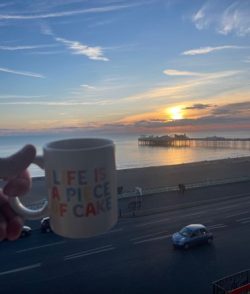Date: 20/11/2023
Author: Isaac Thornton
 Bio:
Bio:
Isaac Thornton is a second-year SCDTP-funded PhD student at the University of Brighton. Situated in the School of Humanities and Social Science, his research sits between Psychology and Social Policy, and his PhD explores resilience and social exclusion among international students in the UK from a social ecological perspective using mixed methods. Prior to starting his PhD, he studied at the University of Sussex, Maastricht University/United Nations University-MERIT, and was a Senior Researcher at the National Centre for Social Research.
Introduction

A painting produced by one participant, who said that painting helped them cope with the stresses of the COVID-19 pandemic.
Often as researchers, we want to understand the lived experiences of our participants, including their feelings, thoughts, and daily activities. In my ongoing PhD research, I explore international students’ experiences of adversity and resilience at the UK universities. That is, the challenges they face and the things, people, and activities that help them to adapt while living in the UK.
A common method used to do this is the one-on-one interview, in which the researcher has a more-or-less structured conversations with participants about a given topic. Discussion and words are of course central to our daily lives; we are constantly talking to others, calling them, sending emails, texting, posting on social media, and so on, while our own internal monologue narrates our day. Interviews play an important role in social research. However, focusing solely on words can mean we miss out on the other sensory aspects of lived experiences.
Consequently, a range of so-called creative methods have been developed to understand participants’ lives in a more rounded way, using images, sounds, touch, and other sensations. One such method is the photo elicitation interview (PEI), and this blog article explains what they are, how they work, and why they are useful.
What are photo elicitation interviews?
In PEI, images, usually photographs, are used to stimulate and guide discussion in an interview (Bates, McCann, Kaye, & Taylor, 2017). Depending on the study, these images might have been taken by the participant, the researcher, or someone else. They might have been produced as part of the study, or have been gathered from already existing images. Typically, the images in question revolve around a set of themes relating to the research question.
Different PEI studies can be described as being more researcher-led or participant-led (Bates et al., 2017). In researcher-led PEI, the researcher provides more detailed instructions about what images participants should use, and perhaps selects the images themselves. Researchers might add structure to the interview by asking a specific set of questions each time. In more participant-led PEI, the participant is given more freedom in the kinds of images they bring to the interview, and the interview itself is more open and flexible, following what the participant wishes to talk about and focusing on the participant produced images.
How do photo elicitation interviews work? An example.
To show how PEI works in practice, here is an example from my PhD research, in which one of my studies addresses the question of how international students experience adversity and resilience.
I used a relatively participant-led approach to photo elicitation interviews for this study, and I will explain the six steps I took in turn.
- Recruitment
I recruited ten international students studying at universities in southeast England, aiming for diversity in in gender, type of programme (bachelor’s, master’s, doctoral), and country of origin. I recruited participants in person, through posters, and using social media. - Briefing
I briefed potential participants in person, via video call, or over email, telling them what the study was about and that they would be expected to share some images relating to their experiences studying in the UK, which we would then discuss in an interview. I provided all participants with written information about the study and gave them some prompts as to what they might include in the images:- Photos/images representing who you were when you came to the UK to study and who you are now.
- Photos/images representing challenges you have faced while studying in the UK and how you felt when dealing with them.
- Photos/images representing things, activities, or people that have helped you when dealing with those challenges, or which made things more difficult.
- Photos/images representing what day-to-day life looks like for you now and how you want things to be in the future.
I used the briefing to arrange a time and place for the interview.
- Time to collect pictures
I gave participants time to take or collect images which represented their experiences studying in the UK. I asked participants to share these with me over email, and offered to print these ahead of in person interviews. Participants shared a range of different images, including photographs, paintings, and images found online. - Interview
After obtaining informed consent from participants, we met individually either in person or online via Microsoft Teams for interviews. Each interview was different. Sometimes we spoke a lot about the photos, sometimes we did not, sometimes I asked more questions, sometimes I needed to say very little. I remained flexible, inviting participants to talk freely about their experiences and the images they shared, but came prepared with a set of questions and prompts to stimulate discussion where necessary. - Analysis
I audio recorded and transcribed (typed up) interviews. I then analysed the transcribed interviews using Braun and Clarke’s (2019) reflexive thematic analysis approach to generate themes, or patterns of shared meaning, across the interviews. However, PEIs are flexible and various analytical approaches can be used. - Reporting
I will report the results of the analysis in relation to theory and my research question in my PhD thesis and a journal article. With participants’ consent, some of their images will be included alongside the reported results.
Why use photo elicitation interviews?

Another participant’s view of Brighton seafront. Brighton as a place was an important part of their study experience.
PEIs have many advantages compared to traditional interviews, which are summarised below:
- Rapport. The use of images can help to build rapport and ease conversation by giving the interviewer and participant something to focus on.
- Easing communication. Images can provide an additional way for participants for whom English is not their first language to make themselves understood.
- New layers of meaning. Using images can reveal more layers of meaning which are not revealed by words alone.
- Giving power to participants. Using participant-produced images means that they have more control over the interview, compared to the interviewer simply asking questions.
- Ease of use. As someone less experienced with qualitative and creative methods, I found PEI to be a flexible and easy to pick up method.
- Images are everywhere. Especially with the advent of social media like Instagram, images are more important than ever to how we communicate and experience the world. PEIs tap into this.
- Fun! Photo elicitation interviews make a refreshing change to traditional research methods, and can be really engaging for the researcher and participants.
PEIs will not be appropriate for every study, but can be incredibly useful way of getting richer information about people’s lived experiences to better inform policy and practice.
Bibliography
Bates, E. A., McCann, J. J., Kaye, L. K., & Taylor, J. C. (2017). “Beyond words”: a researcher’s guide to using photo elicitation in psychology. Qualitative Research in Psychology, 14(4), 459-481.
Braun, V., & Clarke, V. (2019). Reflecting on reflexive thematic analysis. Qualitative Research in Sport, Exercise and Health, 11(4), 589-597.